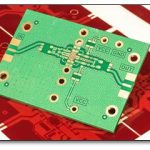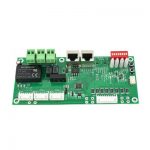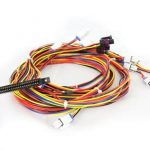Introduction to the HiKey 960
The HiKey 960 is a high-performance development board designed for prototyping, testing and developing applications and software for ARM-based systems. Developed by Linaro and the 96Boards initiative, the HiKey 960 is a powerful and flexible platform that offers a range of features and capabilities for developers and enthusiasts alike.
At the heart of the HiKey 960 is the Kirin 960 SoC (System on Chip), which is an octa-core processor designed by HiSilicon, a subsidiary of Huawei. The Kirin 960 features four ARM Cortex-A73 cores running at up to 2.4 GHz and four ARM Cortex-A53 cores running at up to 1.8 GHz, providing a balance of high performance and energy efficiency.
Key Features of the HiKey 960
The HiKey 960 offers a wide range of features and specifications that make it an attractive choice for developers and enthusiasts. Some of the key features of the board include:
| Feature | Specification |
|---|---|
| SoC | Kirin 960 octa-core (4x ARM Cortex-A73 @ 2.4 GHz, 4x ARM Cortex-A53 @ 1.8 GHz) |
| GPU | Mali-G71 MP8 |
| RAM | 3 GB LPDDR4 @ 1866 MHz |
| Storage | 32 GB UFS 2.1 flash storage |
| Connectivity | 802.11 b/g/n/ac WiFi, Bluetooth 4.1, USB 3.0 Type-C, USB 2.0 Type-A |
| Display | HDMI 1.4 (4K @ 30 Hz), MIPI-DSI (1080p @ 60 Hz) |
| Camera | 4-lane MIPI-CSI, 1080p @ 30 fps |
| Expansion | 40-pin low speed expansion connector, 60-pin high speed expansion connector |
| Power | 12V/2A power supply |
| Dimensions | 85 mm x 55 mm |
Kirin 960 SoC
The Kirin 960 SoC is the cornerstone of the HiKey 960’s performance and capabilities. This octa-core processor combines four high-performance ARM Cortex-A73 cores with four energy-efficient ARM Cortex-A53 cores, allowing for a balance of power and efficiency depending on the task at hand.
The Cortex-A73 cores are designed for demanding tasks such as gaming, video encoding and decoding, and virtual reality applications. These cores can reach clock speeds of up to 2.4 GHz, providing ample performance for even the most demanding applications.
The Cortex-A53 cores, on the other hand, are designed for less intensive tasks and background processes. These cores have a maximum clock speed of 1.8 GHz and are optimized for energy efficiency, helping to extend battery life in mobile and embedded applications.
Mali-G71 MP8 GPU
In addition to the powerful CPU cores, the Kirin 960 SoC also includes an ARM Mali-G71 MP8 GPU (Graphics Processing Unit). This GPU is designed to handle graphics-intensive tasks such as gaming, VR, and UI rendering.
The Mali-G71 architecture is based on the Bifrost architecture, which offers significant improvements in performance and efficiency compared to previous generations. The MP8 variant used in the HiKey 960 features eight shader cores, providing ample graphics processing power for demanding applications.
Memory and Storage
The HiKey 960 is equipped with 3 GB of LPDDR4 RAM, which operates at a speed of 1866 MHz. This high-speed, low-power memory provides ample capacity and bandwidth for multitasking and running memory-intensive applications.
For storage, the board features 32 GB of UFS 2.1 flash storage. UFS (Universal Flash Storage) is a high-performance storage standard that offers faster data transfer speeds and lower power consumption compared to eMMC storage commonly used in other development boards.
Connectivity Options
One of the strengths of the HiKey 960 is its wide range of connectivity options, which allow it to interface with various peripherals and networks.
Wireless Connectivity
The board includes a wireless module that supports 802.11 b/g/n/ac WiFi and Bluetooth 4.1. This allows the HiKey 960 to connect to wireless networks and communicate with Bluetooth devices such as keyboards, mice, and sensors.
USB Ports
The HiKey 960 features two USB ports: a USB 3.0 Type-C port and a USB 2.0 Type-A port. The USB 3.0 port supports high-speed data transfer and can also be used to power the board. The USB 2.0 port is useful for connecting peripherals such as keyboards, mice, and storage devices.
Display Interfaces
For video output, the HiKey 960 offers an HDMI 1.4 port and a MIPI-DSI interface. The HDMI port supports resolutions up to 4K @ 30 Hz, making it suitable for high-resolution displays and TVs. The MIPI-DSI interface can be used to connect to compatible displays, such as those used in mobile devices, and supports resolutions up to 1080p @ 60 Hz.
Camera Interface
The board includes a 4-lane MIPI-CSI interface for connecting camera modules. This interface supports camera resolutions up to 1080p @ 30 fps, making it suitable for applications such as video conferencing, surveillance, and computer vision.

Expansion Capabilities
The HiKey 960 offers two expansion connectors that allow users to extend the functionality of the board by connecting additional hardware modules.
Low Speed Expansion Connector
The 40-pin low speed expansion connector is compatible with the Raspberry Pi’s GPIO (General Purpose Input/Output) header, which means that many existing Raspberry Pi Expansion boards and modules can be used with the HiKey 960. This connector includes interfaces such as:
- GPIO
- I2C
- SPI
- UART
High Speed Expansion Connector
The 60-pin high speed expansion connector provides access to high-bandwidth interfaces, allowing for the connection of more advanced peripherals and modules. This connector includes interfaces such as:
- USB
- PCIe
- MIPI-DSI
- MIPI-CSI
Software Support
The HiKey 960 supports a variety of operating systems and software platforms, making it a versatile tool for developers working on different projects.
Android
The board can run Android 7.1 and later versions, allowing developers to create and test Android applications on a high-performance platform.
Linux
The HiKey 960 supports several Linux distributions, including Debian, Ubuntu, and AOSP (Android Open Source Project). This makes it an ideal platform for developing Linux-based applications and systems.
UEFI
The board also supports UEFI (Unified Extensible Firmware Interface), which is a modern firmware standard that provides a secure and flexible environment for booting operating systems and managing hardware resources.
Applications and Use Cases
The HiKey 960’s combination of performance, connectivity, and expansion capabilities make it suitable for a wide range of applications and use cases, such as:
- Mobile app development and testing
- Embedded systems development
- IoT (Internet of Things) projects
- Robotics and drones
- AI and machine learning
- Edge computing
- Digital signage
- Kiosk systems
- In-vehicle infotainment systems
FAQ
1. What is the difference between the HiKey 960 and the Raspberry Pi?
While both the HiKey 960 and the Raspberry Pi are single-board computers, they target different audiences and have different features. The HiKey 960 is a high-performance board designed for developers and enthusiasts, while the Raspberry Pi is more focused on education and hobbyist projects. The HiKey 960 features a more powerful SoC, more RAM, and faster storage compared to most Raspberry Pi models.
2. Can I use the HiKey 960 as a desktop computer?
Yes, the HiKey 960 can be used as a desktop computer by connecting a display, keyboard, and mouse. However, its primary purpose is for development and testing rather than daily desktop use.
3. Is the HiKey 960 suitable for beginners?
The HiKey 960 is a powerful and complex board that may be challenging for beginners. It is more suitable for experienced developers and enthusiasts who are familiar with embedded systems and Linux development.
4. Can I run Windows on the HiKey 960?
No, the HiKey 960 does not support running Windows due to the ARM architecture of the Kirin 960 SoC.
5. What is the power consumption of the HiKey 960?
The power consumption of the HiKey 960 varies depending on the workload and connected peripherals. The board requires a 12V/2A power supply, which suggests a maximum power consumption of around 24W.
Conclusion
The HiKey 960 is a powerful and versatile development board that offers a compelling combination of performance, connectivity, and expansion capabilities. With its Kirin 960 SoC, Mali-G71 MP8 GPU, and ample memory and storage, the board is well-suited for demanding applications and projects.
The wide range of connectivity options, including WiFi, Bluetooth, USB, HDMI, and MIPI interfaces, allows the HiKey 960 to interface with various peripherals and networks. The board’s expansion connectors further extend its functionality by enabling the connection of additional hardware modules.
With support for popular operating systems and software platforms like Android, Linux, and UEFI, the HiKey 960 caters to developers working on diverse projects across multiple domains, such as mobile app development, embedded systems, IoT, robotics, and more.
While the HiKey 960 may not be the ideal choice for beginners, it is an excellent platform for experienced developers and enthusiasts seeking a high-performance, feature-rich development board for their projects.






Leave a Reply